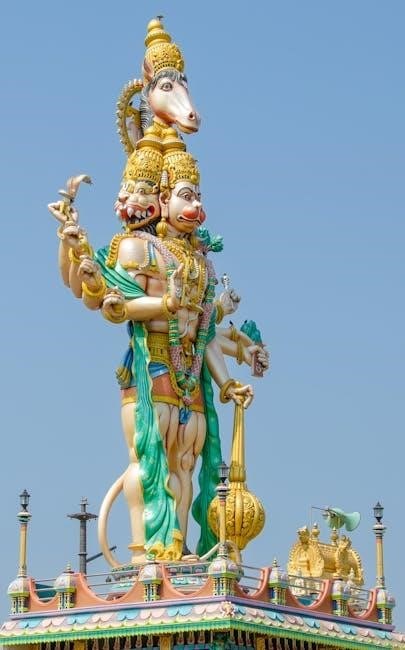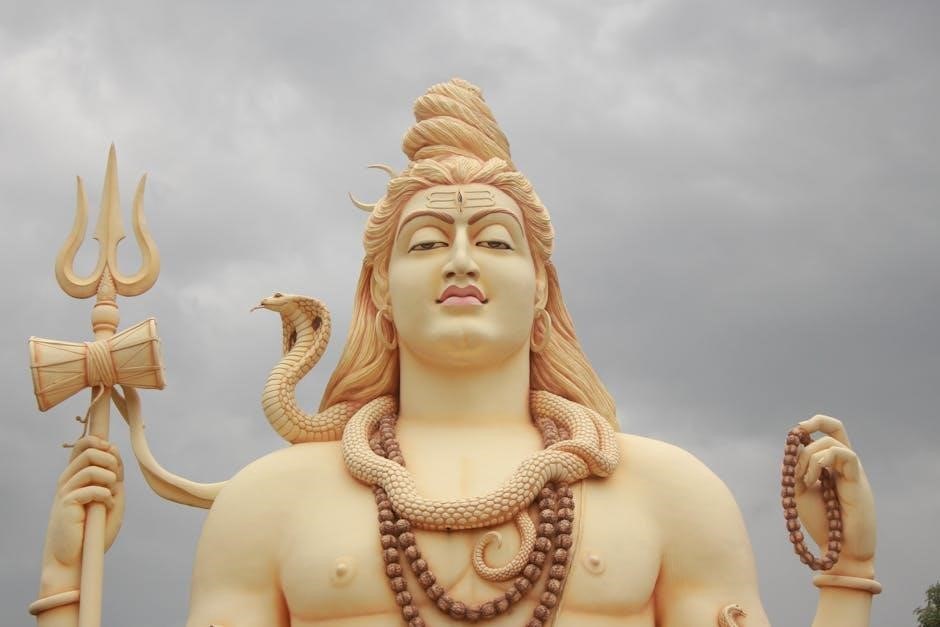Shiva Purana PDF: An Overview
The Shiva Purana, a sacred Hindu text, is readily available in PDF format for easy access․ This digital format allows devotees and scholars to explore its rich content, including stories, teachings, and hymns dedicated to Lord Shiva․
The Shiva Purana stands as one of the eighteen major Puranas, integral to the Shaivism tradition within Hinduism․ This revered text primarily revolves around Lord Shiva and Goddess Parvati, while also paying homage to all deities․ As a part of the Shaivism literature corpus, it delves into the multifaceted aspects of Shiva, encompassing his role in creation, preservation, and destruction․
The Shiva Purana is an ancient source of profound knowledge, culture, and spiritual wisdom, offering insights into cosmology, mythology, yoga, and sacred places․ Its content includes stories, teachings, and hymns dedicated to Lord Shiva, emphasizing devotion (bhakti) and its transformative impact on personal growth․ The text explores the cyclic nature of the universe through Shiva’s divine functions․
Furthermore, the Shiva Purana touches upon Advaita-Vedanta philosophy and theistic Bhakti, providing a comprehensive understanding of Shiva’s significance․ It is available in various languages, including Sanskrit, Hindi, English, Tamil, and Urdu, making it accessible to a global audience․

Availability of Shiva Purana in PDF Format
The Shiva Purana is widely accessible in PDF format, enabling devotees to easily download and read this sacred text․ This digital availability ensures convenient access to its teachings and stories․
Sources for Downloading Shiva Purana PDF
Numerous online platforms offer the Shiva Purana in PDF format, catering to diverse preferences and languages․ Reputable websites, digital libraries, and online archives provide downloadable versions of the text, often accompanied by translations and commentaries․ These sources ensure accessibility for devotees and scholars worldwide․ Some platforms offer scanned versions of original texts, while others provide transcribed and formatted PDFs for easier reading․ It’s crucial to verify the authenticity and accuracy of the source before downloading to ensure a reliable and faithful representation of the Shiva Purana․ Many websites also offer the text in various languages, including Hindi, English, Tamil and others, making it accessible to a global audience․ Always prioritize trusted sources to avoid corrupted files or inaccurate translations․ Exploring different sources allows readers to find a version that suits their reading preferences and language proficiency, enhancing their understanding and appreciation of this sacred scripture․ Ensure the site is secure before initiating a download to protect your device from potential malware․
Shiva Purana PDF in Various Languages (Hindi, English, Tamil, Urdu)
The Shiva Purana is accessible in PDF format across various languages, catering to a global audience․ Hindi versions are widely available, allowing native speakers to delve into the scripture’s teachings․ English translations provide accessibility for those unfamiliar with Sanskrit or Hindi, enabling a broader understanding of the text’s profound wisdom․ Tamil versions cater to the South Indian audience, preserving the cultural significance of the Purana in that region․ Urdu translations also exist, extending the reach of the Shiva Purana to Urdu-speaking communities․ This multilingual availability ensures that diverse audiences can connect with the stories, teachings, and hymns dedicated to Lord Shiva․ Accessing the Shiva Purana in one’s native language enhances comprehension and fosters a deeper connection with the text’s spiritual essence․ Online platforms and digital libraries often host these multilingual versions, making it convenient for individuals worldwide to explore the Shiva Purana in their preferred language․ These translations contribute significantly to the dissemination of Shaivism’s rich philosophical and mythological traditions․

Content and Structure of Shiva Purana
The Shiva Purana contains twenty-four thousand shlokas, divided into six samhitas or sections․ These sections cover diverse aspects of Shiva’s legends, philosophy, and cosmology, offering a comprehensive understanding of Shaivism’s core tenets․
Samhitas (Sections) of Shiva Purana
The Shiva Purana is structured into distinct sections known as samhitas, each focusing on specific aspects of Lord Shiva’s stories and teachings․ These samhitas contribute to the comprehensive nature of the Purana, offering devotees a multifaceted understanding of Shaivism․ The Jnana Samhita delves into philosophical knowledge, while the Vidyeshvara Samhita explores the divine attributes of Shiva․
Other samhitas within the Shiva Purana elaborate on various themes, providing narratives and insights into cosmology, mythology, and yoga․ These sections often contain detailed descriptions of sacred places, known as tirthas, and geographical information relevant to the stories being told․ The arrangement into samhitas allows readers to navigate the vast content of the Shiva Purana more effectively, focusing on areas of particular interest․
Each samhita contributes unique perspectives and stories, collectively painting a rich and detailed picture of Lord Shiva’s divine nature and his role in the universe․ This structured approach makes the Shiva Purana accessible to both scholars and devotees seeking a deeper understanding of Shaiva philosophy․
Key Themes: Devotion, Creation, and Destruction
The Shiva Purana intricately weaves together several key themes, prominently featuring devotion (Bhakti), creation, and destruction․ Devotion to Lord Shiva emerges as a central tenet, emphasizing the importance of unwavering faith and its transformative impact on personal growth․ The Purana highlights how sincere bhakti can lead to spiritual enlightenment and liberation from the cycle of birth and death․
The themes of creation and destruction are intrinsically linked within the Shiva Purana, reflecting the cyclic nature of the universe as explained through Shiva’s role․ Shiva is depicted as the destroyer of illusions and impurities, paving the way for new beginnings․ This concept underscores the constant flux of existence, where destruction is not an end but a necessary precursor to creation․
Through narratives and teachings, the Shiva Purana explores the interplay between these themes, illustrating how devotion to Shiva enables individuals to navigate the cycles of creation and destruction with wisdom and understanding․ The stories emphasize the importance of surrendering to the divine will and recognizing the interconnectedness of all things within the cosmic dance of Shiva․

Significance of Shiva Purana
The Shiva Purana holds immense significance within Hinduism, particularly for followers of Shaivism․ It serves as a vital source of ancient knowledge, culture, and spiritual wisdom, offering profound insights into the nature of reality․
Relevance to Shaivism
The Shiva Purana is fundamentally important to Shaivism, the Hindu tradition that reveres Lord Shiva as the Supreme Being․ Within Shaivism, this Purana functions as a primary scripture, elaborating on Shiva’s divine nature, his various manifestations, and his cosmic role in the creation, preservation, and destruction of the universe․
It provides a comprehensive understanding of Shiva’s attributes, symbols, and associated rituals, guiding devotees in their worship and spiritual practices․ The text details the importance of bhakti (devotion) towards Shiva, emphasizing its transformative power in attaining liberation and union with the divine․
Furthermore, the Shiva Purana reinforces the philosophical underpinnings of Shaivism, including its unique perspectives on cosmology, metaphysics, and ethics․ It narrates numerous stories and legends that exemplify Shiva’s grace, compassion, and power, inspiring devotees to cultivate a deep and abiding connection with him․ By studying and internalizing the teachings of the Shiva Purana, followers of Shaivism can deepen their understanding of Shiva and progress on their spiritual journey․
Philosophical Aspects: Advaita-Vedanta and Bhakti
The Shiva Purana beautifully weaves together elements of Advaita-Vedanta philosophy and the path of Bhakti, offering a unique spiritual synthesis․ While rooted in the non-dualistic principles of Advaita, which posits the ultimate oneness of the individual soul (Atman) with the Supreme Reality (Brahman), the Purana emphasizes the importance of devotion and personal relationship with Lord Shiva․
It portrays Shiva as both the transcendent, impersonal Brahman and the immanent, compassionate Lord who responds to the heartfelt prayers of his devotees․ The text highlights the significance of bhakti (devotion) as a means to realize this inherent unity, emphasizing that through love, surrender, and selfless service, one can transcend the limitations of ego and experience the blissful union with Shiva․
The Shiva Purana thus reconciles the seemingly contradictory paths of knowledge (jnana) and devotion (bhakti), suggesting that true knowledge dawns only when coupled with unwavering love and devotion towards the divine․ This harmonious blend makes the Shiva Purana accessible and appealing to a wide range of spiritual seekers․
Understanding Shiva Through Shiva Purana
The Shiva Purana offers profound insights into understanding Lord Shiva․ It details his various aspects, stories, and significance, providing devotees with a comprehensive view of Shiva’s divine nature and his role in the cosmos․
108 Names of Lord Shiva
Within the Shiva Purana, Lord Shiva is revered through a compilation of 108 names, each encapsulating a unique attribute and manifestation of the deity․ These names serve as a powerful tool for devotees to connect with Shiva’s divine energy and comprehend his multifaceted nature․
Each name holds profound significance, revealing aspects of Shiva’s cosmic roles, his benevolent nature, and his fierce power․ Chanting these names, either individually or as a collective mantra, is considered a potent practice for invoking Shiva’s blessings and attaining spiritual growth․
The 108 names provide a pathway to understanding Shiva’s essence, from his role as the destroyer of illusions to his embodiment of compassion and grace․ Reciting them fosters devotion, deepens meditation, and facilitates a closer relationship with the divine․
Some popular names include Mahadeva (the great God), Nataraja (the lord of dance), and Bholenath (the simple lord)․ Each name offers a glimpse into Shiva’s vastness and his accessibility to those who seek him with sincerity․
Stories of Goddess Sati
The Shiva Purana narrates the poignant stories of Goddess Sati, Shiva’s first consort, highlighting her unwavering devotion and tragic fate․ Sati’s tales are integral to understanding the dynamics between Shiva and Shakti, the divine feminine energy․
Sati, the daughter of Daksha, defied her father’s disapproval to marry Shiva, drawn to his ascetic nature and divine power․ However, Daksha harbored resentment towards Shiva and organized a grand yagna (ritual sacrifice) without inviting him or Sati, a deliberate insult․
Consumed by anger and grief at her father’s disrespect towards her husband, Sati immolated herself in the sacrificial fire․ This act of self-sacrifice demonstrated her profound love for Shiva and her inability to bear the dishonor inflicted upon him․
Shiva, upon learning of Sati’s death, was overcome with rage and sorrow․ He unleashed his wrath upon Daksha’s yagna, ultimately beheading Daksha․ The stories of Sati emphasize themes of devotion, sacrifice, and the consequences of disrespecting the divine․

Where to read Shiva Purana online
For those seeking to delve into the sacred verses of the Shiva Purana, numerous online platforms offer access to this revered text․ Digital libraries and online archives provide convenient avenues for reading and studying the Shiva Purana from the comfort of one’s home․
Reputable online bookstores and e-commerce sites also provide access to digital versions of the Shiva Purana, allowing readers to purchase and download the text for offline reading․ Additionally, some organizations and institutions dedicated to promoting Hindu culture and philosophy may offer free access to the Shiva Purana on their websites․
Before accessing the Shiva Purana online, it is advisable to verify the credibility and authenticity of the source to ensure accurate and reliable content․

